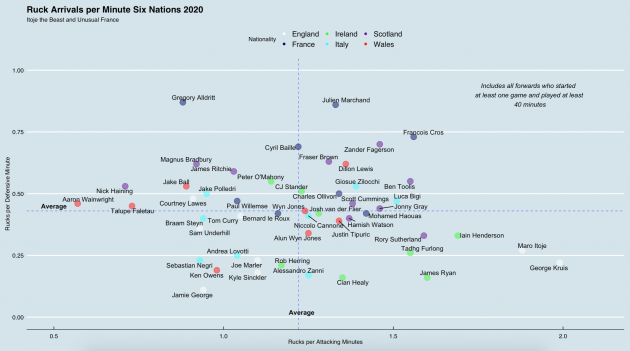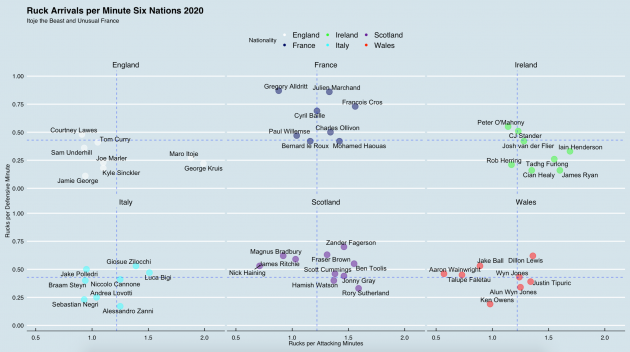The championship may be over for now but Sam Larner has been in his stats bunker working out which players have stood out
Six Nations Analysis: The top performers in 2020
Writing an article on the final round of the Six Nations has been complicated by the lack of a final round of the Six Nations. If all goes to plan we will be finishing off the tournament closer to Halloween than Easter.
Luckily, as other people have been hoarding toilet paper I have been hoarding rugby statistics. Enough to pull together the best nuggets from the three, or four, depending on which team you support, rounds so far…
The Best Carriers
We remember the game-breaking carries but just as important are the frequent carriers. Typically these are the forwards who must fight through the tightly packed defenders to create the space for the backs to make their memorable runs on the outside.

The first thing to look at in this graph is the top right section. That indicates players who have made more carries than average and done more with each carry than the average.
Wales centre Nick Tompkins stands out here. Not only did he make lots of carries, he didn’t let the quality drop with each one. He was able to make the highlight-reel carries, like the one below, but he was also able to take the strain off the forwards with regular carries.
No stopping him! @WelshRugbyUnion debutant Nick Tompkins goes straight through the heart of Italy's defence for a top-class try#WALvITA #GuinnessSixNations pic.twitter.com/OJCqnMnO3f
— Guinness Six Nations (@SixNationsRugby) February 1, 2020
Stuart Hogg was the flashy star. He didn’t have too many opportunities, but he made the most of what he did have. That is really the job of a full-back: do the best with the limited opportunities that come your way. The same is true of wingers.
With a lighter workload than some of his Scotland colleagues, Hogg was leaned on to create the tries. Something he did with aplomb against Italy in the first clip below…
Round Three had some special tries.
We can't wait for more in Round Four. #GuinnessSixNations pic.twitter.com/MSI6SjKkQW
— Guinness Six Nations (@SixNationsRugby) March 3, 2020
Arguably the most impressive performance was by Frenchman Gregory Alldritt. He was one of the reasons why France were able to do so well in the truncated tournament. He carried the most of anyone in the tournament and still finished above average for the results of those carries, including the try below.
Antoine Dupont with the vision ?
Gregory Alldritt with the finish ?
What a try from @FranceRugby! ?#FRAvITA #GuinnessSixNations pic.twitter.com/AvL6vNjJWA
— Guinness Six Nations (@SixNationsRugby) February 9, 2020
Something to bear in mind if you are new to the game is the importance of the carry success. If you can carry the ball forward you create opportunities for the rest of your team to attack a retreating defence. That creates a favourable attacking environment. If you cannot carry forwards, the defence has the upper hand because they are able to keep pushing you back.
Alldritt and players like Justin Tipuric and Jake Polledri were able to go forwards and create space for everyone else to operate in. For attack coaches that is crucial for their game plans, but the players doing that work can often be forgotten in favour of team-mates who are scoring the tries and making significant line breaks.
The Unseen Work
If you are new to rugby you may be confused by some of the Man of the Match decisions, which are awarded to people who didn’t score tries or kick points. These awards are usually given for the ‘unseen work’; the jobs that need doing but won’t make highlight tapes.
The best example of this is breakdown work. A successful carry isn’t just dependent on the ball-carrier. The ball-carrier may gain ten metres but if they immediately lose the ball because there are no support players that would not be a success.
We rarely think about the job those support players do but there are stats collected for just that purpose.

The data in this graph is taken per attacking minute and defensive minute spent on the pitch. So a player on a team who defended a lot wouldn’t see that penalised in their attacking rucks score.
What is impressive is the work-rate of Maro Itoje and George Kruis. Both players hit almost two rucks every attacking minute. That is in addition to the carrying, dummy running and passing they must also do. This is hugely beneficial to the team because it frees the other forwards to go and make more effective carries without having the fatigue associated with hitting so many rucks.

On the ball: George Kruis and Maro Itoje in England training (Getty Images)
A good way of looking at this is to think of your own job. You almost certainly have a hefty workload but imagine if a temp came in and took 25% of your work off you, how much more effective would you be?
Itoje and Kruis are the temps for England, creating opportunities for the likes of Tom Curry, Sam Underhill and Courtney Lawes to be more effective.
You may also have looked at the graph and questioned why so many French players are near the top of the graph. We can look at that in more detail by breaking out the different teams and putting them into their own graphs.

The French really stand out now. They were hitting far more defensive rucks than any of the other teams. This looks like a deliberate tactic brought in by Shaun Edwards. He wanted France to slow down opposition ball by hitting the rucks and trying to turn the ball over.
You can see a similar tactic for both Scotland and Wales, who had the majority of their players hitting more defensive rucks than average but neither came close to France.
This is something we can expect to see France continuing to do given the level of success they had in the tournament so far. The downside is that this requires extreme levels of fitness. France fell away in their first match against England as time passed and let in 14 of 23 points in the second half against Wales.
When Edwards has had a full year with the French squad, you can expect those weaknesses to disappear.

French tactic: Antoine Dupont kicks clear from a ruck (Getty Images)
Conclusion
These other stats give us an idea of what else is going on in the game of rugby besides tries and points. Even if you pay close attention to a match it is easy to miss some of the work done by the players.
When you next get an opportunity to watch a match – and I hope that isn’t many months off – try to look out for how players influence the game even without the ball. That may be through their support play at the breakdown or the carries which are made after their initial carry made ground.
If you can identify these situations you will be able to understand everything that goes on in a match, not just the highlights.
The April issue of Rugby World magazine – focusing on a new generation of Six Nations stars – is out now.
Follow Rugby World on Facebook, Instagram and Twitter.





